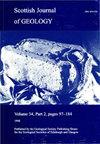苏格兰石炭纪一新种根瘤菌的研究
IF 1.3
4区 地球科学
Q4 GEOLOGY
引用次数: 0
摘要
从苏格兰米德兰山谷的几个石炭纪地点回收的材料中描述了一种新的根茎opsis。单个真皮颅骨是从北拉纳克郡韦斯特布拉科的废弃煤渣尖上获得的,这些煤渣来自最初覆盖在Drumgray煤上的页岩。单个真皮颅骨保存完好,允许详细描述和重建头骨顶部和脸颊。兰氏根opsis rankini sp. 11 .的特征是在颞骨和板骨之间有裂片状的眼状、深嵌的顶骨后盾状和增大的外侧肩胛外肌。根茎藓属在这里包括在巨型鱼纲,并修订诊断的家庭是给出。综述了根霉属植物的组成。除汉布氏根瘤菌、兰氏根瘤菌和索氏根瘤菌外,其余种均以鳞片为基础。对这些基于尺度的种的有效性进行了重新评估,除细粒根opsis和马祖根opsis外,其余种均被认为是有效种。专题收藏:这篇文章是苏格兰古生物学收藏的一部分,可在:https://www.lyellcollection.org/topic/collections/palaeontology-of-scotland本文章由计算机程序翻译,如有差异,请以英文原文为准。
On a new species of
Rhizodopsis
from the Carboniferous of Scotland
A new species of
Rhizodopsis
is described from material recovered from several Carboniferous locations within the Midland Valley of Scotland. Individual dermal skull bones were obtained from derelict coal waste tips at Wester Bracco, North Lanarkshire from shales originally overlying the Drumgray Coal. Individual dermal skull bones are well preserved, allowing for detailed description and reconstructions of the skull roof and cheek.
Rhizodopsis rankini
sp. nov. is distinguished by the presence of a lobed opercular, a deeply embayed postparietal shield between the supratemporal and tabular bones, and enlarged lateral extrascapulars.
Rhizodopsis
is here included in the Megalichthyidae, and an emended diagnosis of the family is given. The composition of the genus
Rhizodopsis
is reviewed. Except for R
hizodopsis hanbuchi, Rhizodopsis rankini
and
Rhizodopsis sauroides
, all other species are based solely on scales. The validity of these scale-based species is reassessed and all but
Rhizodopsis granulatus
and
Rhizodopsis mazonius
are considered to be valid species.
Thematic collection:
This article is part of the The Palaeontology of Scotland collection available at:
https://www.lyellcollection.org/topic/collections/palaeontology-of-scotland
求助全文
通过发布文献求助,成功后即可免费获取论文全文。
去求助
来源期刊

Scottish Journal of Geology
地学-地质学
CiteScore
1.70
自引率
0.00%
发文量
10
审稿时长
>12 weeks
期刊介绍:
Although published only since 1965, the Scottish Journal of Geology has a long pedigree. It is the joint publication of the Geological Society of Glasgow and the Edinburgh Geological Society, which prior to 1965 published separate Transactions: from 1860 in the case of Glasgow and 1863 for Edinburgh.
Traditionally, the Journal has acted as the focus for papers on all aspects of Scottish geology and its contiguous areas, including the surrounding seas. The publication policy has always been outward looking, with the Editors encouraging review papers and papers on broader aspects of the Earth sciences that cannot be discussed solely in terms of Scottish geology.
The diverse geology of Scotland continues to provide an important natural laboratory for the study of earth sciences; many seminal studies in geology have been carried out on Scottish rocks, and over the years the results of much of this work had been published in the Journal and its predecessors.
The Journal fully deserves its high reputation worldwide and intends to maintain its status in the front rank of publications in the Earth sciences.
 求助内容:
求助内容: 应助结果提醒方式:
应助结果提醒方式:


